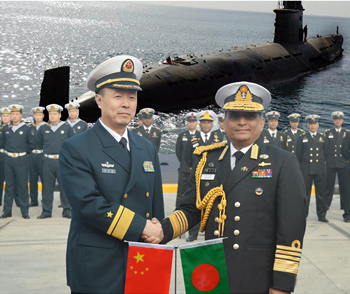INDIAN ARMED FORCES CHIEFS ON
OUR RELENTLESS AND FOCUSED PUBLISHING EFFORTS

SP Guide Publications puts forth a well compiled articulation of issues, pursuits and accomplishments of the Indian Army, over the years

I am confident that SP Guide Publications would continue to inform, inspire and influence.

My compliments to SP Guide Publications for informative and credible reportage on contemporary aerospace issues over the past six decades.
Chinese submarines to Bangladesh
 |
By Lt. General P.C. Katoch (Retd) Former Director General of Information Systems, Indian Army |

Bangladesh media, quoting an Inter Services Public Relation Directorate release, reported on November 4 that Bangladesh Naval Chief Admiral Nizamuddin Ahmed had received two Chinese submarines during a ceremony at Liao Nan Shipyard in Liaoning province's Dalian city, China. These two Ming class submarines were actually handed over to Nizamuddin Ahmed on October 31 in a ceremony. These Type 035G class submarines will join the Bangladesh naval fleet at the beginning of next year, and will be named BNS 'Nabajatra' and BNS 'Joyjatra'. China's Ming class submarine is developed from the Russian Romeo Class submarine of the 1950's, latter in turn having been based on the German Type XXI submarine of World War II. However, in developing the Ming class submarine, Chinese undertook extensive modification of the Russian Romeo Class submarine.
The Ming class submarines are diesel-electric submarines that displace 2,110 tons and have a surfaced endurance of 8,000 nm allowing them to stay at sea for about 60 days. They are manned by a crew of 57 personnel and carry 18 torpedoes with an option for carrying 32 mines also. Bangladesh has reportedly paid over US$203 million for these two submarines for orders that were placed in 2013. Bangladesh originally wanted to order the S 20 and Type 039 Song class submarines but since these were costing US$350 million per submarine, decided to go for the less costly Ming class costly. Chinese President Xi Jinping made a two-day visit to Bangladesh in October, the first by a Chinese President in 30 years. Bangladesh and China signed 27 deals and memorandum of understanding (MoUs) totaling US$13.6 billion. Both countries agreed to "elevate China-Bangladesh ties from a comprehensive partnership of cooperation to a strategic partnership of cooperation." The two countries also announced that 2017 would be observed as the "year of exchange and friendship" that will see a series of diplomatic, cultural and educational visits. China is Bangladesh's largest trading partner, so the country is eager to increase trade even further. However, Bangladesh has voiced its concern about the ever expanding trade deficit. Significantly, China's arms exports globally have grown by 88% over the last decade. Pakistan is the largest consumer of Chinese defence exports, absorbing 35%. However, the second largest consumer is Bangladesh, followed by Myanmar.
Bangladesh accounted for 20% of all the Chinese arms export during the past five years. China views Bangladesh as an important player in implementing China's One Belt, One Road (OBOR) initiative, as well as the Bangladesh-China-India-Myanmar (BCIM) economic corridor. Xi's trip was a strategic move to ensure Dhaka does not lean more towards India. Bangladesh is sovereign country and can buy defence equipment from any country it wishes. But what raises concerns are the Chinese moves to tighten its 'String of Pearls' aimed to encircle India. The China-Pakistan Economic Corridor (CPEC) running through Gilgit-Baltistan to Balochistan and beyond to Gwadar has strategic ramifications for India. China aims similarly, through her investments, OBOR and BCIM, in Bangladesh. By her actions, China continues to indicate her intent of shrinking India's strategic space in South Asia as well as in the IOR, behind which is her concept of combative engagement with India. As part of her encirclement strategy, China believes in bringing smaller states in the ambit of her gravitational pull. Significantly, the previous BNP-led regime in Bangladesh was pro-China-Pakistan and what may be termed hostile to India with some for major anti-India terrorist training camps running in Bangladesh with instructors from Pakistani proxies. Presently, Sheikh Hasina's government is doing the utmost to stamp out terrorism and India-Bangladesh relations are extremely friendly. However, the ISIS footprints continue in Bangladesh and a recent survey done in Bangladesh reveals that some 10% of university students in Bangladesh are in favour of terrorism.
This would raise concerns in Bangladesh and India but perhaps would fit Chinese plans considering that she has well managed institutionalize radicalism and export of terrorism by Pakistan to further her own national interests. As it is, development projects undertaken by China globally have covert presence of PLA and selective placement of Chinese Special Forces. When the two Ming class submarines imported from China arrive in Bangladesh, part of the crew would likely be PLA Navy (PLAN) personnel who would continue for some period of time to guide personnel of Bangladesh Navy for handling these vessels through the initial stage of operations, as well as maintenance. In all probability, PLA Navy (PLAN) personnel would also be providing assistance in setting up shore infrastructure: repair yards, training facilities, and: operational support establishments for smooth conduct of submarine operations. Future China-Bangladesh joint naval exercises also involving submarines of both countries would be natural fallout. Within two weeks of Bangladesh getting its first submarine from China, Defence Minister Manohar Parrikar visited Dhaka, first Indian Defence Minister to do so. Bangladesh Prime Minister Sheikh Hasina, who also holds defence portfolio discussed measures to strengthen military and security ties. India has offered Bangladesh help by Indian PSUs build military production capabilities of Bangladesh. Sheikh Hasina is expected to visit India in the near future.
The views expressed herein are the personal views of the author.





